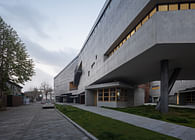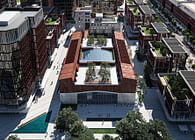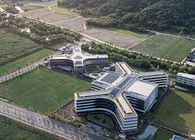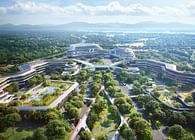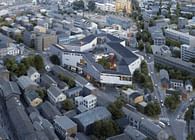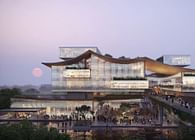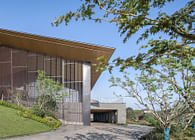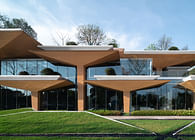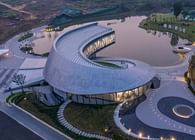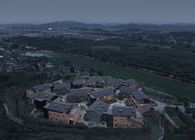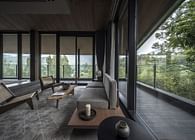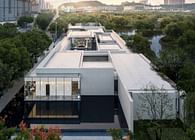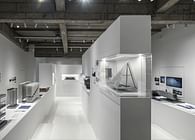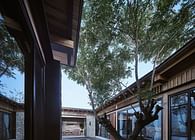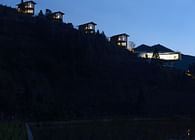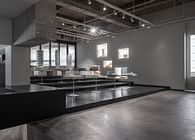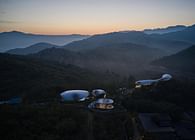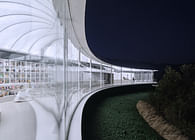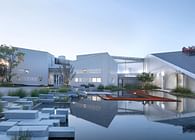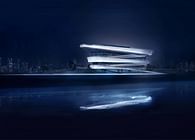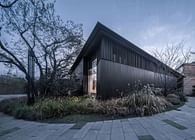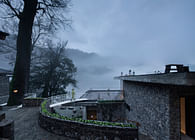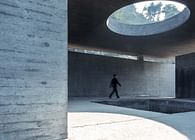
"Heritage conservation and urban renewal require a dynamic, dialectical approach—sustaining historical memory while allowing new possibilities to emerge." —— Zhu Peidong
On September 27th, Taipingqiao Block 122 (Lakeville Luxe Phase VI) sold out on its launch day, setting a new record for luxury home sales in China. Located in the heart of Shanghai's Xintiandi, in the Huangpu District, this project completes Shui On Land’s 20-year transformation of the Taipingqiao Xintiandi community.
The land release policies of the time, combined with regulatory adjustments throughout the city's development and rising public awareness of heritage preservation, significantly increased the difficulty of the project. It became one of the most complex and challenging renewal efforts among Shanghai's recent historic neighborhoods.
The complexity extended beyond reorganizing the road network. It required a detailed analysis of buildings with varying protection levels, from heritage sites to historically significant structures. The project also integrated diverse architectural forms, merging traditional alleys with high-rise towers, and mixed-use functions such as residential, commercial, recreational, and transport facilities. Balancing heritage preservation, development returns, and public needs further heightened the challenge.
In 2020, Dr. Zhu Peidong, Co-Founder and Chief Architect of line+ studio, was commissioned by Shui On Land to act as the design consultant and lead architect for the vision planning of the Taipingqiao Block 122 urban renewal. Rather than focusing solely on historical restoration, line+ re-envisioned the site from the perspective of dynamic urban evolution, proposing a dual strategy of 'Renewal' and 'Jinshan.' This strategy aimed to strike a balance between preserving historical continuity and addressing the demands of future development.
“Regeneration” emphasizes revitalization through a dialectical preservation of historical character and adaptive reuse, allowing the past to thrive within a contemporary context. “Jinshan” symbolizes innovation and reconstruction, drawing from the East-West fusion characteristic of Shikumen architecture, and fostering the harmonious coexistence of old and new, modern and historic elements.
01
Tracing the Roots:
Historical Sensitivity and Mixed-Use Complexity
Taipingqiao Community’s architectural character, shaped in the early 20th century, spans 52 hectares and includes 23 blocks, primarily featuring Shikumen alleyways. By the mid-1990s, issues like overcrowding, deteriorating buildings, and insufficient public infrastructure prompted local authorities to initiate redevelopment. This included partnering with developers like Shui On Land and adopting policies such as land leasing to transform the area.
Block 122, in the southeastern part of Taipingqiao, spans 24,000 square meters and was once home to the Dongtai Road Antique Market, a popular spot for both local and international visitors. Surrounded by Fuxing Middle Road, South Xizang Road, Zizhong Road, and Jian Road, it borders the Taipingqiao Greenbelt and CPIC Xintiandi Commercial Center.
The development will include 23,900 square meters of residential space and 100,000 square meters of commercial space, with 35% dedicated to preserving low-rise historical buildings.
To maintain the integrity of the low-rise fabric, additional capacity is concentrated in a 180-meter super high-rise, Shanghai’s tallest approved residential building. Located in the northwest, it complements the 250-meter tower of the adjacent CPIC Xintiandi Commercial Center, forming the eastern gateway to Taipingqiao. This placement completes the skyline around Taipingqiao Green Space while minimizing shadow impact on nearby low-rise areas.
02
Renewal and Integration:
Alleyways as the Core and Framework of Urban Regeneration
Following the principle of heritage preservation, an integrated renewal strategy was adopted for the Shikumen alleyways. Existing textures, architectural features, and spatial forms were analyzed to retain and showcase their historical significance. Contemporary functions and materials were seamlessly integrated to create spaces that reinterpret and extend traditional living patterns.
Alleyways are key elements of residential neighborhoods, functioning as community units. The ‘Li’ (Alley) refers to the basic administrative or development unit, varying in scale and architectural style, linked by ' Nong’ (Lane) to form 'fang,' the residential space unit. These units align with the city's overall layout. Block 122 includes over ten such 'li,' such as Dahua Li, Jixiang Li, Rende Li, Wende Li, Rongsheng Li, Yong'an Li, Ziyang Li, Chengye Li, Xingan Li, Quanyu Li, and Renshou Li.
After nearly a century of evolution, the alleyway layout has become overcrowded and chaotic, with narrow, disordered passages. The original 'li' units are seen as the 'cells' of urban renewal, while the historical street and alley networks are restored as the 'framework.' This new framework, scaled to modern use, shapes the master layout for the urban renewal vision.
The on-site Shikumen buildings differ in historical significance and are categorized accordingly: 12 heritage-protected buildings, 16 preserved structures, and 59 general historical buildings. They undergo preservation, renovation, or reconstruction, based on their classification.
Heritage-protected buildings are preserved in situ or relocated and reconstructed. Poorer-condition structures, such as Dahua Li, are replaced with better-preserved buildings. Well-preserved historical buildings are safeguarded through on-site preservation, relocation, or facade restoration. General historical buildings are either reconstructed or newly built, reinterpreting the style while maintaining the area's overall texture and character.
03
Jinshan Renewal:
Reconstructing Urban Form and Public Life
The original layout of Block 122’s Shikumen alleyways featured outer alleyways lining the perimeter, encircling a central grid of inner lanes. Ground floors typically housed commercial spaces along the perimeter, while the upper levels remained residential.
The renewal of the street-facing interface adopts the 'Jinshan Regeneration' strategy, innovatively combining traditional and modern architectural elements and functions. While maintaining coherence with the overall urban fabric, the street scale is restored, and characteristic styles are preserved. Contemporary design techniques and materials are incorporated into the traditional 'residential-above, shops-below' configuration, facilitating the integration of modern public life.
The plan extends Dongtai Road through the site, connecting it to the Pacific Xintiandi Commercial Center to the north, establishing a seamless commercial street interface. At the southeastern corner, Laoximen Metro Station is designated as a key public node, with its scale expanded to create a commercial plaza that draws pedestrian traffic and extends northward along the commercial street.
The extension of Dongtai Road divides the site into two distinct blocks, with the primary and secondary alleyways restoring the traditional height-to-width ratio of street spaces and courtyard scales. Certain larger alleyway nodes are reimagined as garden plazas. While integrating seamlessly into the urban fabric, the overall texture of these blocks fosters a high-quality, tranquil living environment amidst the vibrant surroundings.
04
Heritage Preservation Through Continuity,
Urban Renewal Through Innovation
Over time, the Dongtai Road Antique Market, originally established on the project site in the 1980s, has evolved into Lakeville Luxe Phase VI, a nationally recognized landmark residential community. This transformation has contributed to the completion of the Taipingqiao Xintiandi community in its final, fully realized form.
As a product of Shanghai’s historical development, Block 122 has unique characteristics while also reflecting common patterns in real estate-driven urban renewal. The main challenge lies not in preserving texture and facades, but in maintaining the city’s vitality and street culture as traditional neighborhoods and markets transform into high-end residences and fashionable commercial zones. Comparative studies with historical maps guided efforts to preserve as much of the original fabric and scale as possible, aiming to restore the neighborhood’s authentic living atmosphere. By innovating spatial patterns, the project accommodates diverse contemporary urban life and functions.
The recognition of the urban renewal plan with the 2023 Shanghai Excellent Urban and Rural Spatial Planning Design Award has been a significant boost. The final implementation, developed through institutional collaboration, retained much of the original planning framework and strategies. It upheld the vision of preserving the site's cultural and historical heritage while achieving strong sales despite industry challenges. This demonstrates that academic reflections on urban history and culture need not conflict with commercial development strategies. Instead, it emphasizes the role of urban renewal in reorganizing contemporary urban elements, revitalizing cultural energy, and balancing diverse values.
Project Name:The Visionary Urban Renewal Plan for Shanghai's Taipingqiao Block 122
Design Firm:line+ studio
Website: www.lineplus.studio
Contact: pr@lineplus.studio
Chief Architect/Project Principal: Zhu Peidong
Design Team:Wu Haiwen、Hu Jianqi、Ren Hengyi、Zhang Qiqi、Hong Yang
Technical Drawing: Du Mengying
Commercial Design Consultant: Studio Shanghai
Regulatory Plan Adjustment:Shanghai Yingyi Urban Planning Design Co.,Ltd
Preliminary Historical Character Value Assessment: Shanghai Tongji Urban Planning&Design Institute Co., Ltd.
Preliminary Historical Building Preservation Plan: Shanghai Zhangming Architectural Design Firm
Client: Shui On Development Limited
Location: Huangpu District, Shanghai
Floor Area:99560㎡
Design Period:2020.8-2021.5
Status: Unbuilt
Location: Shanghai, CN






